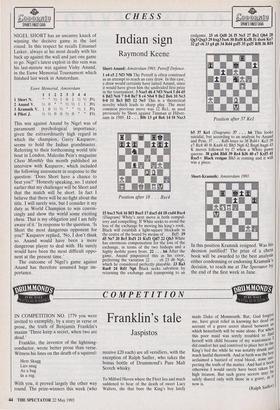CHESS
Indian sign
Raymond Keene
NIGEL SHORT has an uncanny knack of winning the decisive game in the last round. In this respect he recalls Emanuel Lasker, always at his most deadly with his back up against the wall and just one game to go. Nigel's latest exploit in this vein was his last-minute win against Vishy Anand, in the Euwe Memorial Tournament which finished last week in Amsterdam.
Euwe Memorial, Amsterdam
1 1 2 2 3 3 4 4
1 Short N. * * 1/2 1 0 1 1/2 1/2 31/2 2 Anand V. 1/2 0 * * 1/2 1/2 1 1 31/2 3 Kramnik V. 1 0
1/2
1/2
* * 1/2
1 31/2 4 Piket J.
1/2 1/2
0 0
1/2
0 * * 11/2
This win against Anand by Nigel was of paramount psychological importance, given the extraordinarily high regard in which the champion, Garry Kasparov, seems to hold the Indian grandmaster. Referring to their forthcoming world title bout in London, Malcolm Fein's magazine Chess Monthly this month published an interview with Kasparov, which included the following assessment in response to the question: `Does Short have a chance to beat you?' Honestly speaking, no. I stated earlier that my challenger will be Short and that the match will be short. In fact I believe that there will be no fight about the title. I will surely win, but I consider it my duty as World Champion to win convin- cingly and show the world some exciting chess. That is my obligation and I am fully aware of it.' In response to the question, 'Is Short the most dangerous opponent for you?' Kasparov replied, 'No, I don't think so. Anand would have been a more dangerous player to deal with. He surely would have been the most difficult oppo- nent at the present time.'
The outcome of Nigel's game against Anand has therefore assumed huge im- portance.
Short-Anand: Amsterdam 1993; Petroff Defence.
1 e4 e5 2 NO Nf6 The Petroff is often construed as an attempt to reach an easy draw. In this case, a draw would certainly have suited Anand, since it would have given him the undivided first prize in the tournament. 3 NxeS d6 4 Nf3 Nxe4 5 d4 d5 6 Bd3 Nc6 7 0.0 Bel 8 c4 Nb4 9 Bet Be6 10 Nc3 0-0 11 Be3 Bf5 12 Ne5 This is a theoretical novelty which leads to sharp play. The most common previous move was 12 Rcl , as used previously by Short against Timman at Hilver- sum in 1989. 12 . Bf6 13 g4 Be6 14 f4 Nxc3
Position after 18 . . Bxc4 15 bxc3 Nc6 16 Bf3 Bxe5 17 dxe5 d4 18 cxd4 Bxc4 (Diagram) White's next move is both compul- sory and compelling. If White seeks to avoid the loss of the exchange by moving his king's rook, Black will establish a light-square blockade in the centre of the board by means of . . . Bd5. 19 d5 Ne7 20 Bc5 Bxfl 21 1Cxf1 Qd7 22 Qb3 White has enormous compensation for the loss of the exchange, in terms of the two bishops and a highly mobile pawn front. 22 . . . b6 After the game, Anand pinpointed this as his error, preferring the variation 22 . . . c6 23 d6 Ng6, which he considered perfectly playable. 23 Ba3 RaeS 24 Rdl Ng6 Black seeks salvation by returning the exchange and transposing to an
endgame. 25 e6 Qd8 26 f5 Ne5 27 Be2 Qh4 28 Qg3 Qxg3 29 hxg3 fxe6 30 BxfS KxfS 31 dxe6 Ke7 32 g5 c6 33 g4 g6 34 Rd4 gxf5 35 gxf5 Rf8 36 Rf4
Position after 37 Kel b5 37 Kel (Diagram) 37 . . . h6 This looks suicidal, but according to an analysis by Anand and Pein, 37 . . Kd6 loses to 38 Rd4+ Kc5 39 e7 Re8 40 f6 Kxd4 41 Bh5 Ng6 42 Bxg6 hxg6 43 K moves followed by f7 when a White pawn queens. 38 gxh6 Rh8 39 Re4 Kf6 40 e7 KxfS 41 Rxe5+ Black resigns Bh5 is coming and it will win a piece.
Short-Kramnik: Amsterdam 1993.
In this position Kramnik resigned. Was his decision justified? The prize of a chess book will be awarded to the best analysis either condemning or endorsing Krarnnik's decision, to reach me at The Spectator by the end of the first week in June.


















































 Previous page
Previous page